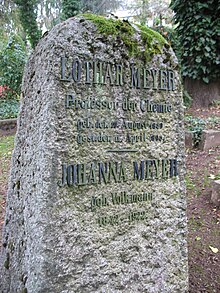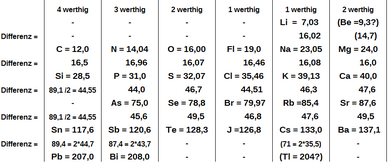Lothar Meyer
Julius Lothar (from 1892: von ) Meyer (born August 19, 1830 in Varel , Oldenburg , † April 11, 1895 in Tübingen ) was a German doctor and chemist . Along with Dmitri Mendeleev, he is one of the founders of the periodic table of chemical elements.
Life
Meyer was the fourth of seven children of medical officer Friedrich August Meyer and his wife Sophie geb. Beer man. His younger brother was the physicist Oskar Emil Meyer (1834–1909). He first attended a private school, then the newly founded community school (forerunner of the Lothar-Meyer-Gymnasium now named after him ) and then the Old Gymnasium Oldenburg (Oldb). In 1851 he began studying medicine in Zurich , which he completed in Würzburg in 1854 with the doctorate De quibusdam nervi sympathici functionibus .
Then he worked for a short time with Robert Wilhelm Bunsen in Heidelberg with gas analysis methods. In 1856 he began a second degree in mathematical physics in Königsberg . In 1858 he was awarded a doctorate in Breslau with a thesis on the effect of carbon monoxide on the blood ( De sanguine oxydo carbonico infecto ). phil. PhD .
It was only now that Meyer turned to chemistry and completed his habilitation in February 1859 on the subject of The Chemical Teachings of Berthollet and Berzelius. In Breslau he worked as a private lecturer and head of the chemical laboratory of the Physiological Institute. In 1866 he switched to teaching at the Neustadt-Eberswalde Forest Academy , where he married Johanna Volkmann (1842-1922), daughter of the Chemnitz lawyer and company director Julius Volkmann (1804-1873). In March 1867 he was appointed professor there. Here he also wrote several reviews for the Zeitschrift für Chemie. In 1868 he was appointed full professor to succeed Karl Weltzien at the Karlsruhe Polytechnic . There he occupied the chair for pure chemistry.
In 1877 he succeeded Rudolph Fittig at the University of Tübingen .
Services
Lothar Meyer became known as a co-founder of the periodic table . Meyer, who started teaching from 1859, like Dmitri Iwanowitsch Mendeleev, put together the teaching material himself in the absence of suitable templates. In 1860 Meyer, like Mendeleev, took part in the first big chemists' meeting in Karlsruhe , at which important basic terms of chemistry such as atom and molecule - especially the ideas of Stanislao Cannizzaro - were made known. In 1864 his book The Modern Theories of Chemistry was published , which was reprinted several times. Here Meyer put the ideas about atoms and molecules together clearly and worked out a first version of a periodic table.
Following a communication from Mendeleev in 1869, Meyer wrote the treatise The nature of chemical elements as a function of their atomic weights. In this publication he gave reflections on the elements of today's main groups - sorted according to atomic weight and valency in periods of six groups. For this he received the Davy Medal from the British Royal Society in 1882 together with Dmitri I. Mendeleev . He also founded the Journal for Physical Chemistry in 1887 together with William Ramsay and Mendelejew .
On March 6, 1869, Mendeleev published the Periodic Table of the Elements (PSE) under the title The dependence of the chemical properties of the elements on the atomic weight. The 63 elements known at the time were arranged in order of the atomic mass in seven groups with similar properties. A few months later, Lothar Meyer published an almost identical table. With his system in 1871, he was able to predict the properties of the previously unknown elements gallium (Mendeleev: Eka-aluminum), scandium (Mendeleev: Eka-boron) and germanium (Mendeleev: Eka-silicon).
Other important services were:
- a contribution to the structure of benzene : In 1865 Meyer proposed a carbon ring with a saturation of the six free carbon valences directed towards the core .
- the investigation of the periodic dependence of atomic volume on atomic weight.
- the recalculation of the atomic weights of the chemical elements (1883).
Honors
In 1892 he was awarded the Knight of Honor Cross of the Order of the Württemberg Crown , with which the nobility was associated. He died in Tübingen in 1895, where he is also buried.
In Tübingen , the university's Lothar Meyer building was named after him.
In 1975 the Lothar-Meyer-Gymnasium in Varel was dedicated to him.
In 1983 Pete J. Dunn named a new calcium - zinc - manganese - arsenate containing crystalline water as Lotharmeyerit in honor of Lothar Meyer . The name of Lothar Meyer lives on in the other mineral species, which were named accordingly due to their crystal-chemical relationship with Lotharmeyerite: Ferrilotharmeyerite (Fe 3+ -dominant analogue of the Zn-dominated Lotharmeyerite), cobalt solderarmyerite (co-dominant analogue), nickellotharmeyerite (Ni dominant analog), and manganese solder armyerite (Mn 3+ dominant analog).
In 2020 Meyer was honored with a Google Doodle on his 190th birthday .
Fonts
- The gases of the blood. Dieterich, Göttingen 1857 (dissertation, medicine, Würzburg; digitized ).
- De Sanguine Oxydo Carbonico Infecto. Grass, Barth et Soc., Breslau 1858 (dissertation, chemistry, Breslau).
- Chemical analysis of the healing springs in Bad Landeck (Prussian Silesia). Gosohorsky, Breslau 1863 ( digitized version ).
-
The modern theories of chemistry and their significance for chemical statics. Maruschke & Berendt, Breslau 1864 ( digitized version ).
- 2nd revised and much increased edition. Maruschke & Berendt, Breslau 1872 ( digitized version ).
- The nature of the chemical elements as a function of their atomic weights. In: Annals of Chemistry and Pharmacy . VII. Supplementary Volume 1870, pp. 354-364. Reprinted in: The Natural System of Chemical Elements. Treatises by Lothar Meyer (1864–1869) and D. Mendelejeff (1869–1871) (= Ostwald's Classics of Exact Sciences 68). Edited by Karl Seubert . Engelmann, Leipzig 1895, pp. 9-17 ( digitized version ).
- The future of German universities and their preparatory training institutions. Maruschke & Berendt, Breslau 1878 ( digitized ).
- with Karl Seubert : The atomic weights of the elements recalculated from the original numbers. Breitkopf & Härtel, Leipzig 1883 ( digitized version ).
-
Basics of theoretical chemistry. Breitkopf & Härtel, Leipzig 1890 ( digitized version ).
- 2nd Edition. Breitkopf & Härtel, Leipzig 1893 ( digitized version ).
- The modern theories of chemistry and their relevance to chemical mechanics. Maruschke & Berendt, Breslau 1884 ( digitized version ).
- The beginnings of the natural system of chemical elements. Treatises by JW Doebereiner , 1829, and Max Pettenkofer 1850, together with a historical overview of the further development of the theory of the triads of the elements (= Ostwald's classic of the exact sciences. No. 66). Edited by Lothar Meyer. Engelmann, Leipzig 1895 ( digitized version ).
literature
- Georg Bredig : Meyer, Lothar . In: Allgemeine Deutsche Biographie (ADB). Volume 55, Duncker & Humblot, Leipzig 1910, pp. 830-833.
- Klaus Danzer: Dmitri I. Mendelejew and Lothar Meyer. The creators of the periodic table of the chemical elements. Teubner, Leipzig 1971 ( biographies of outstanding natural scientists and technicians ).
- Peter Haupt: Meyer, Julius Lothar. In: Hans Friedl u. a. (Ed.): Biographical manual for the history of the state of Oldenburg . Edited on behalf of the Oldenburg landscape. Isensee, Oldenburg 1992, ISBN 3-89442-135-5 , p. 460 ( online ).
- Harald Kluge, Ingrid Kästner: A pioneer of physical chemistry in the 19th century - Julius Lothar Meyer (1830–1895). (= European Science Relations , Supplement 1), ISBN 978-3-8440-3269-7 .
- Otto Krätz : Meyer, Lothar. In: New German Biography (NDB). Volume 17, Duncker & Humblot, Berlin 1994, ISBN 3-428-00198-2 , pp. 304-306 ( digitized version ).
- Günter Schwanicke: From the life of the chemist Julius Lothar Meyer and about his epoch-making work in the field of chemistry in the 19th century. Heimatverein Varel, Varel 1995 ISBN 3-924113-17-3 .
- Meyer, Julius Lothar. In: Winfried R. Pötsch, Annelore Fischer and Wolfgang Müller with the assistance of Heinz Cassebaum : Lexicon of important chemists . Bibliographisches Institut, Leipzig 1988, ISBN 3-323-00185-0 , p. 299 f.
- Otto Theodor Benfey: Meyer, Julius Lothar . In: Charles Coulston Gillispie (Ed.): Dictionary of Scientific Biography . tape 9 : AT Macrobius - KF Naumann . Charles Scribner's Sons, New York 1974, p. 347-353 .
- Isaac Asimov : Biographical Encyclopedia of Natural Sciences and Technology , Herder, Freiburg / Basel / Vienna 1974, ISBN 3-451-16718-2 , p. 321
Web links
- Literature by and about Lothar Meyer in the catalog of the German National Library
- Periodic table according to Lothar Meyer (1870) in HTML format
- Dagmar Szöllösi: Julius Lothar Meyer - one of the fathers of the periodic table. In: TU spectrum - magazine of the Technical University of Chemnitz-Zwickau . 1/1995, archived from the original on December 22, 2003 .
Individual evidence
- ↑ Volume 10, Volume 3. Quandt & Handel, Leipzig 1867, pp. 160, 192, 320, 447.
- ↑ 40 years of the CTI in 1892 , page LXXII.
- ↑ University professor Tübingen .
- ^ Meyer, Julius Lothar; The modern theories of chemistry (1864); table on page 137, https://reader.digitale-sammlungen.de/de/fs1/object/goToPage/bsb10073411.html?pageNo=147
- ↑ Lothar Meyer: The nature of the chemical elements as a function of their atomic weights , Lieb. Ann. Suppl. VII ( 1870 ), pp. 354-364.
- ^ Günther Bugge: The book of the great chemists , Verlag Chemie, Volume II, 1974, p. 233.
- ^ Court and State Handbook of the Kingdom of Württemberg 1894, page 36. Readable via US server
- ↑ Lothar-Meyer-Bau on TÜpedia.
- ↑ Pete J. Dunn: Lotharmeyerite, a new mineral from Mapimi, Durango, Mexico . In: The Mineralogical Record . tape 14 , 1983, p. 35-36 .
- ↑ H. Gary Ansell, Andrew C. Roberts, Pete J. Dunn, William D. Birch, Valerie E. Ansell, Joel D. Grice: Ferrilotharmeyerite, a new Ca-Zn-Fe 3+ hydroxyl arsenate from Tsumeb, Namibia . In: The Canadian Mineralogist . tape 30 , 1993, pp. 215-217 .
- ↑ Werner Krause, Herta Effenberger, Heinz-Jürgen Bernhardt, Mirko Martin: Cobaltlotharmeyerite, Ca (Co, Fe, Ni) 2 (AsO 4 ) 2 (OH, H 2 O) 2 , a new mineral . In: New yearbook for mineralogy, monthly books . tape 1999 , 1999, pp. 505-517 .
- ↑ Werner Krause, Heinz-Jürgen Bernhardt, Herta Effenberger, Mirko Martin: Cobalttsumcorite and nickellotharmeyerite, two new minerals from Schneeberg, Germany: description and crystal structure . In: New yearbook for mineralogy, monthly books . tape 2001 , 2001, p. 558-576 .
- ↑ Joel Brugger, Sergey V. Krivovichev, Uwe Kolitsch, Nicolas Meisser, Michael Andrut, Stefan Ansermet, Peter C. Burns: Description and crystal structure of manganlotharmeyerite, Ca (Mn 3+ , □, Mg) 2 {AsO 4 , [AsO 2 (OH) 2 ]} 2 (OH, H 2 O) 2 , from the Starlera Mn Deposit, Swiss Alps, and a redefinition of lotharmeyerite . In: The Canadian Mineralogist . tape 40 , 2002, p. 1597-1608 .
- ↑ Julius Lothar Meyer: A very nice Google Doodle for the 190th birthday of the German PSE founder - GWB. In: GoogleWatchBlog. August 19, 2020, accessed on August 19, 2020 (German).
- ↑ Karl Marx , who owned this edition ( Marx-Engels-Gesamtausgabe . Department IV. Volume 32. Akademie Verlag, Berlin 1999, ISBN 3-05-003440-8 , p. 460, no. 888), prepared extensive excerpts from it Book to ( Marx-Engels-Gesamtausgabe. Department IV. Volume 31: Natural science excerpts and notes mid-1877 to early 1883. Akademie Verlag, Berlin 1999, ISBN 3-05-003399-1 , pp. 5-466).
| personal data | |
|---|---|
| SURNAME | Meyer, Lothar |
| ALTERNATIVE NAMES | Meyer, Julius Lothar (full name); Meyer, Lothar von |
| BRIEF DESCRIPTION | German doctor and chemist |
| DATE OF BIRTH | August 19, 1830 |
| PLACE OF BIRTH | Varel , Oldenburg |
| DATE OF DEATH | April 11, 1895 |
| Place of death | Tübingen |



